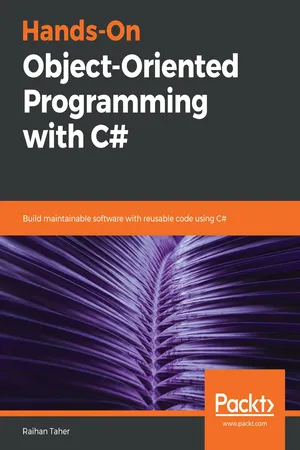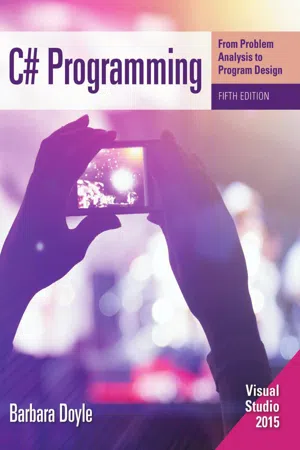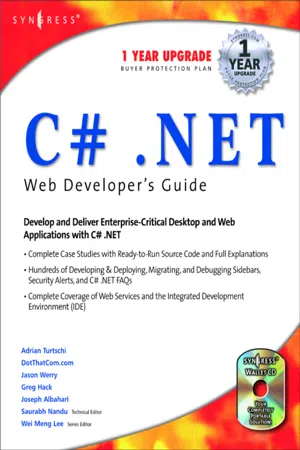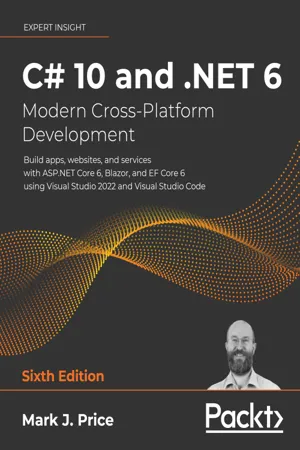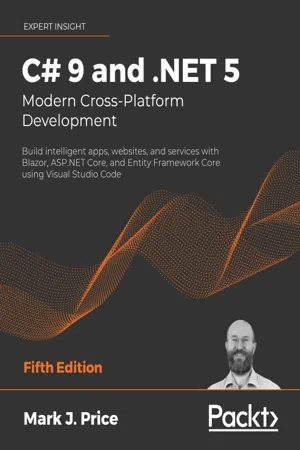Computer Science
C Sharp
C Sharp, often written as C#, is a popular programming language developed by Microsoft. It is widely used for building Windows applications, web services, and games. C# is an object-oriented language that offers strong typing, scalability, and a rich set of libraries, making it a versatile choice for software development.
Written by Perlego with AI-assistance
Related key terms
1 of 5
9 Key excerpts on "C Sharp"
- eBook - ePub
Hands-On Object-Oriented Programming with C#
Build maintainable software with reusable code using C#
- Raihan Taher(Author)
- 2019(Publication Date)
- Packt Publishing(Publisher)
Overview of C# as a Language
With the introduction of modern-day programming practices, it is evident that developers are looking for more advanced constructs to help them to deliver the best software in the most effective way. Languages that evolve on top of frameworks are built to enhance the capabilities of the developers in a way that allows them to quickly build their code with less complexity so that the code is maintainable, yet readable.There are many high-level object, oriented programming languages available on the market, but among them I would say one of the most promising is C#. The C# language is not new in the programming world and has existed for over a decade, but with the dynamic progress of the language itself creating so many newer constructs, it has already left some of the most widely accepted language competition behind. C# is an object-oriented, type-safe, general-purpose language that is built on top of the .NET framework that was developed by Microsoft and approved by theIn this chapter, we will cover the following topics:European Computer Manufacturers Association(ECMA ) and theInternational Standards Organization(ISO ). It is built to run on the Common Language Infrastructure and can interact with any other languages that are built based on the same architecture. Inspired by C++, the language is rich in delivering the best of breed applications without handling too many complexities in code.- Evolution of C#
- Architecture of C#
- Fundamentals and syntax of the C# language
- Visual Studio as an editor
- Writing your first program in Visual Studio
Passage contains an image
Evolution of C#
C# has been one of the most dynamic languages in recent times. This language is open source and mostly driven by a group of software engineers, whorecently came up with lots of major changes to enhance the language and provide features to handle the complexities in the languages that exist. Some of the major enhancements that have been put forward for the language include Generics - eBook - PDF
C# Programming
From Problem Analysis to Program Design
- Barbara Doyle, , , (Authors)
- 2015(Publication Date)
- Cengage Learning EMEA(Publisher)
15. .NET is a software environment in which programs run. It is not the oper-ating system. It is a layer between the operating system and other applica-tions, providing an easier framework for developing and running code. 16. Through using Visual Studio (which is an IDE) and the .NET Framework classes, C# provides an easy way to create GUIs. Copyright 2016 Cengage Learning. All Rights Reserved. May not be copied, scanned, or duplicated, in whole or in part. Due to electronic rights, some third party content may be suppressed from the eBook and/or eChapter(s). Editorial review has deemed that any suppressed content does not materially affect the overall learning experience. Cengage Learning reserves the right to remove additional content at any time if subsequent rights restrictions require it. 60 | Chapter 1: Introduction to Computing and Application Development 17. C# is being used to develop mobile apps for multiple platforms includ-ing iOS and Android. 18. C# can be used to create Web, Windows, and console applications. 19. Webpages can be created using Web forms, which are part of the ASP.NET technology. 20. Windows applications are considered desktop bound and designed for a single platform. 21. Console applications are the easiest to create. Values can be entered and produced with minimal overhead. 22. C# programs usually begin with a comment or using directives, followed by an optional namespace grouping and then the required class definition. 23. All C# programs must define a class . 24. Comments are written as notes to yourself or readers of your program. The compiler ignores comments. 25. It is not necessary to end single inline comments ( // ); they end when the Enter key is pressed. Comments that span more than one line should be enclosed between /* */ . These are considered block or multiline comments. 26. Many classes make up the Framework class library. A class contains data members and methods or behaviors that can be reused. - eBook - PDF
- Adrian Turtschi, Jason Werry, Greg Hack, Joseph Albahari(Authors)
- 2002(Publication Date)
- Syngress(Publisher)
Introducing C# Programming Solutions in this chapter: 34 Chapter 2 • Introducing C# Programming Introduction Let’s start with your first look into the C# language.This chapter teaches you to write, build, and execute console applications.This provides the groundwork for developing applications that use more advanced features of .NET in later chapters. The C# language is a modern object-oriented language. In some ways, it can be seen as an extension of other languages that came before it. C# is most often compared with Java and C++. If you are not familiar with C# programming, this chapter gets you started. If you are familiar with Java or C++, you may want to just skim this chapter because the concepts presented will look very familiar to you. If you already know C#, feel free to skip this chapter entirely.We assume you have a basic understanding of at least one object-oriented language. We’ve mentioned that C# is a modern object-oriented language. Let’s take a little time to explain what we mean by that. C# is a modern language. It supports the notion of data types, flow of control statements, operators, arrays, properties, and exceptions. Depending on the language(s) you are accustomed to program-ming in, most of these concepts should be familiar to you.Throughout the chapter, you will see examples and/or discussions of most of these features of C#. C# is an object-oriented language. It supports the notion of classes and the object-oriented nature of classes including encapsulation, inheritance, and poly-morphism. C# also supports interfaces in conjunction with the .NET Common Language Runtime (CLR) garbage collection, which some feel is necessary in an object-oriented language. It also supports the notion of indexers, which in sim-plified terms lets you manipulate objects as arrays and delegates, which you can think of as method callbacks on steroids. - Joyce Farrell(Author)
- 2017(Publication Date)
- Cengage Learning EMEA(Publisher)
(The newest version of C# is C# 7.0; the version number tells you there were six major versions prior to the most recent release.) Unlike other programming languages, C# allows every piece of data to be treated as an object and to consistently employ the principles of object-oriented programming. C# provides constructs for creating components with properties, methods, and events, making it an ideal language for modern programming, where building small, reusable components is more important than building huge, stand-alone applications. You can find Microsoft’s C# specifications at msdn.microsoft.com . Search for C# specifications . Copyright 2016 Cengage Learning. All Rights Reserved. May not be copied, scanned, or duplicated, in whole or in part. Due to electronic rights, some third party content may be suppressed from the eBook and/or eChapter(s). Editorial review has deemed that any suppressed content does not materially affect the overall learning experience. Cengage Learning reserves the right to remove additional content at any time if subsequent rights restrictions require it. 10 C H A P T E R 1 A First Program Using C# If you have not programmed before, the differences between C# and other languages mean little to you. However, experienced programmers will appreciate the thought that was put into C# features. For example: • C# contains a GUI interface that makes it similar to Visual Basic, but C# is considered more concise than Visual Basic. • C# is modeled after the C++ programming language, but is considered easier to learn. Some of the most difficult features to understand in C++ have been eliminated in C#. Some differences between C# and C++ are that pointers (variables that hold memory addresses) are not used in C# (except in a mode called unsafe, which is rarely used), object destructors and forward declarations are not needed, and using #include files is not necessary.- No longer available |Learn more
- June Jamrich Parsons(Author)
- 2016(Publication Date)
- Cengage Learning EMEA(Publisher)
1995 C# Pronounced “C Sharp,” this language was developed by Microsoft and is more closely related to Java than to C. It is primarily used by developers working within the Windows plat-form. 2001 Swift The newest language in this roster, Swift was created by Apple and is intended to replace Objective-C for OS X and iOS software development. 2014 FIGURE 11-22 (CONTINUED) QUICKCHECK Which of the following languages is generally used for legacy programming projects? a. C++ b. Java c. Swift d. COBOL Copyright 2017 Cengage Learning. All Rights Reserved. May not be copied, scanned, or duplicated, in whole or in part. Due to electronic rights, some third party content may be suppressed from the eBook and/or eChapter(s). Editorial review has deemed that any suppressed content does not materially affect the overall learning experience. Cengage Learning reserves the right to remove additional content at any time if subsequent rights restrictions require it. TOOLSETS Programming languages can be downloaded and installed just like any soft-ware application. Interactive programming environments are also available online as Web apps that don’t require installation. Serious programmers typically download and install programming tools for local use, however, and the language is just one component of their toolset. What tools do programmers use? In addition to a programming lan-guage, the programmer’s toolbox may include a complier, a debugger, and an editor. Some programmers like to obtain programming tools à la carte by picking up a compiler from one vendor, selecting an interactive debugger from another vendor, and using any handy editor, such as Notepad. More typically, programmers download or purchase an SDK or IDE that contains a collection of programming tools. What is an SDK? An SDK (software development kit) is a collection of language-specific programming tools that enables a programmer to develop applications for a specific computer platform, such as Windows PCs. - eBook - PDF
Microsoft® Visual C# 2015
An Introduction to Object-Oriented Programming
- Joyce Farrell, , , (Authors)
- 2015(Publication Date)
- Cengage Learning EMEA(Publisher)
Editorial review has deemed that any suppressed content does not materially affect the overall learning experience. Cengage Learning reserves the right to remove additional content at any time if subsequent rights restrictions require it. 37 Chapter Summary Chapter Summary • A computer program is a set of instructions that tell a computer what to do. Programmers write their programs, then use a compiler to translate their high-level language statements into intermediate language and machine code. A program works correctly when both its syntax and logic are correct. • Procedural programming involves creating computer memory locations, called variables, and sets of operations, called methods. In object-oriented programming, you envision program components as objects that are similar to concrete objects in the real world; then you manipulate the objects to achieve a desired result. OOP techniques were first used for simulations and GUIs. • Objects are instances of classes and are made up of attributes and methods. Object-oriented programming languages support encapsulation, inheritance, and polymorphism. • The C# programming language was developed as an object-oriented and component-oriented language. It contains many features similar to those in Visual Basic, Java, and C++. • To produce a line of console output in a C# program, you must pass a literal string as an argument to the System.Console.WriteLine() method. System is a namespace and Console is a class. Calls to the WriteLine() method can appear within the Main() method of a class you create. • You can define a C# class or variable by using any name or identifier that begins with an underscore, a letter, or an @ sign. These names can contain only letters, digits, underscores, and the @ sign, and cannot be C#-reserved keywords. • You can improve programs by adding comments, which are nonexecuting statements that you add to document a program or to disable statements when you test a program. - eBook - PDF
- Benjamin Perkins, Jon D. Reid(Authors)
- 2021(Publication Date)
- Wrox(Publisher)
To keep languages such as the .NET version of Visual Basic as similar as possible to their predecessors yet compliant with the CLR, certain features of the .NET code library are not fully supported, or at least require unu- sual syntax. By contrast, C# can make use of every feature the .NET code library has to offer. Also, each new ver- sion of .NET has included additions to the C# language, partly in response to requests from develop- ers, making it even more powerful. Applications You Can Write with C# .NET has no restrictions on the types of applications that are possible. C# uses the framework and therefore has no restrictions on possible applications. However, here are a few of the more common application types: ➤ ➤ Desktop applications—Applications, such as Microsoft Office, that have a familiar Win- dows look and feel about them. This is made simple by using the Windows Presentation Foundation (WPF) module of .NET, which is a library of controls (such as buttons, toolbars, menus, and so on) that you can use to build a Windows user interface (UI). ➤ ➤ Cloud/web applications—.NET includes a powerful system named ASP.NET Core, for gener- ating web content dynamically, enabling personalization, security, and much more. Addition- ally, these applications can be hosted and accessed in the cloud, for example on the Microsoft Azure platform. ➤ ➤ Mobile applications—Using both C# and Xamarin mobile UI framework you can target mo- bile applications that target the Android operating system. ➤ ➤ Web APIs—An ideal framework for building RESTful HTTP services that support a broad variety of clients, including mobile devices and browsers. These are also referred to as REST APIs. 10 ❘ CHAPTER 1 INTRODUCING C# ➤ ➤ WCF services—A way to create versatile distributed applications. With WCF, you can exchange virtually any data over local networks or the Internet, using the same simple syntax regardless of the language used to create a service or the system on which it resides. - Mark J. Price(Author)
- 2021(Publication Date)
- Packt Publishing(Publisher)
02
Speaking C#
This chapter is all about the basics of the C# programming language. Over the course of this chapter, you'll learn how to write statements using the grammar of C#, as well as being introduced to some of the common vocabulary that you will use every day. In addition to this, by the end of the chapter, you'll feel confident in knowing how to temporarily store and work with information in your computer's memory.This chapter covers the following topics:- Introducing the C# language
- Understanding C# grammar and vocabulary
- Working with variables
- Exploring more about console applications
Introducing the C# language
This part of the book is about the C# language—the grammar and vocabulary that you will use every day to write the source code for your applications. Programming languages have many similarities to human languages, except that in programming languages, you can make up your own words, just like Dr. Seuss!In a book written by Dr. Seuss in 1950, If I Ran the Zoo- Mark J. Price(Author)
- 2020(Publication Date)
- Packt Publishing(Publisher)
02
Speaking C#
This chapter is all about the basics of the C# programming language. Over the course of this chapter, you'll learn how to write statements using the grammar of C#, as well as being introduced to some of the common vocabulary that you will use every day. In addition to this, by the end of the chapter, you'll feel confident in knowing how to temporarily store and work with information in your computer's memory.This chapter covers the following topics:- Introducing C#
- Understanding the basics of C#
- Working with variables
- Working with null values
- Further exploring console applications
Introducing C#
This part of the book is about the C# language—the grammar and vocabulary that you will use every day to write the source code for your applications. Programming languages have many similarities to human languages, except that in programming languages, you can make up your own words, just like Dr. Seuss!In a book written by Dr. Seuss in 1950, If I Ran the Zoo , he states this:"And then, just to show them, I'll sail to Ka-Troo And Bring Back an It-Kutch, a Preep, and a Proo, A Nerkle, a Nerd, and a Seersucker, too!"Understanding language versions and features
This part of the book covers the C# programming language and is written primarily for beginners, so it covers the fundamental topics that all developers need to know, from declaring variables to storing data to how to define your own custom data types.Advanced and obscure topics like ref local variable reassignment and reference semantics with value types are not covered.This book covers features of the C# language from version 1.0 up to the latest version, 9.0. If you already have some familiarity with older versions of C# and are excited to find out about the new features in the most recent versions of C#, I have made it easier for you to jump around by listing language versions and their important new features below, along with the chapter number and topic title where you can learn about them.
Index pages curate the most relevant extracts from our library of academic textbooks. They’ve been created using an in-house natural language model (NLM), each adding context and meaning to key research topics.
